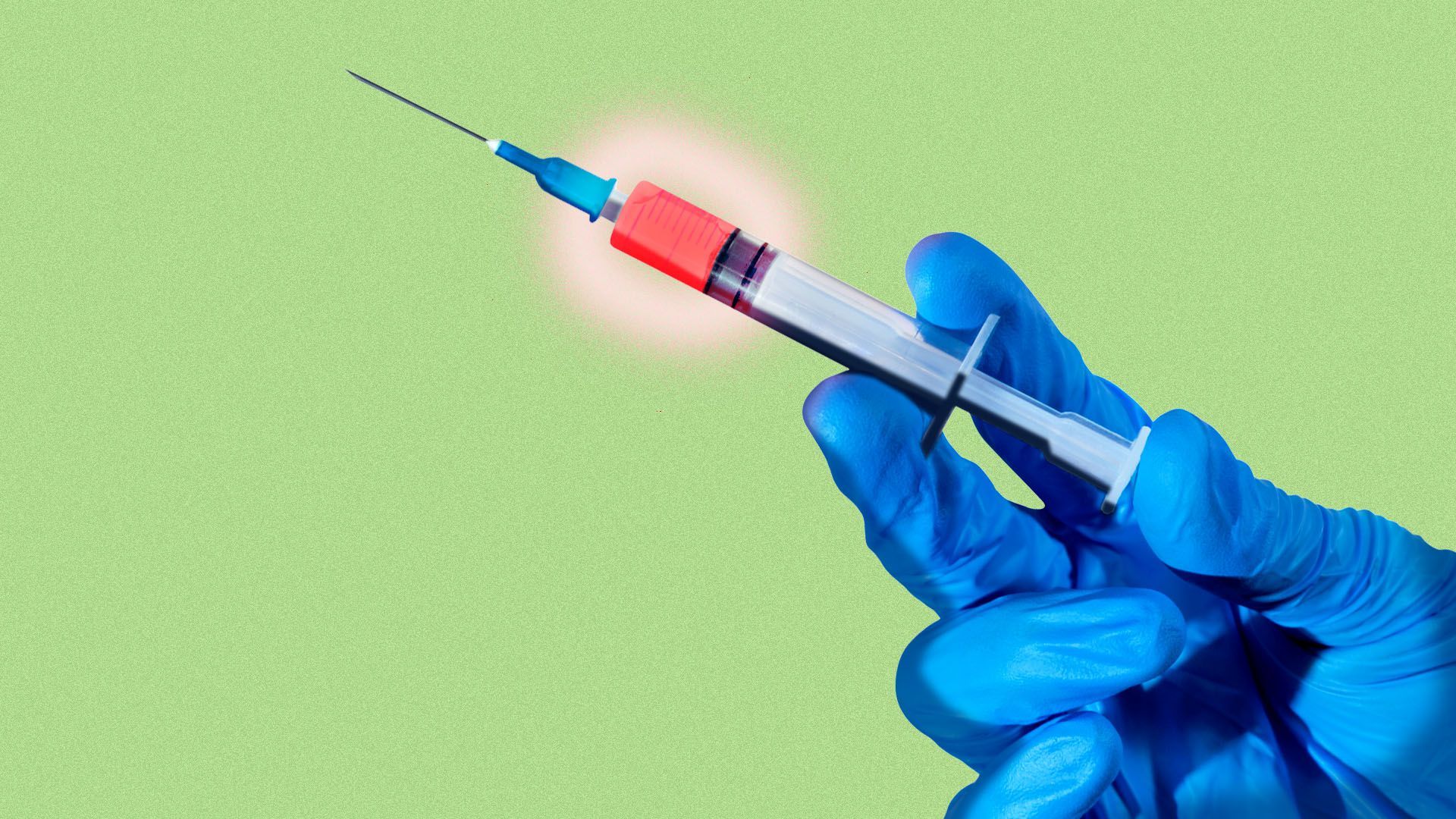| |
| |
| |
| Presented By UnitedHealth Group |
| |
| Vitals |
| By Caitlin Owens ·Nov 17, 2020 |
| Good morning. Today's word count is 1,356, or a 5-minute read. |
| |
| |
| 1 big thing: More good news as the crisis deepens |
 |
|
| Illustration: Sarah Grillo/Axios |
| |
| We're living in a pandemic split screen: There are now two coronavirus vaccines in the late stage of development that appear to be highly effective. - But the first Americans will likely receive them against a backdrop of yet-to-be-seen pandemic horrors.
Why it matters: The end of the pandemic is increasingly in sight. But today's case counts all but ensure that the U.S. won't make it there without the nightmare scenario of overrun health systems all across the country. Driving the news: Moderna announced yesterday that its vaccine is nearly 95% effective — a week after Pfizer made a similarly encouraging announcement. - Moderna also said its vaccine appears to have prevented severe infections, a detail left unaddressed in the Pfizer announcement.
- Additionally, it appears to have protected elderly participants and participants of color — groups ravaged by the pandemic.
- It's still unclear how long the immunity offered by either vaccine would last. That has implications for manufacturing and how frequently people would need boosters, as well as for the ongoing risk of transmitting the virus, as STAT notes.
What we're watching: Both vaccines will likely file for emergency authorizations from the Food and Drug Administration over the next few weeks, and the two companies combined are expected to produce enough doses for 35 million people by the end of the year. Yes, but: The number of doses Moderna is expected to produce this year "won't even cover all of America's frontline health care workers," tweeted Angela Rasmussen, a virologist with Georgetown University. "So my take home message is we still have many months to go." |
    |
| |
| |
| 2. COVID cases are peaking in most of the country |
 Data: CSSE Johns Hopkins University; Map: Andrew Witherspoon/Axios While some parts of the country endured high rates of coronavirus infection in the spring and summer, most of the country is experiencing the worst of it right now, Axios' Andrew Witherspoon reports. By the numbers: Most American counties — 58% of them — have seen the peak of their coronavirus infections this month, and 76% of counties have peaked at some point in the fall. Regional breakdown: Using a seven-day average of cases to smooth out daily variances in reporting, 97% of Midwestern counties cases peaked this Fall. - 22% of the Northeast peaked in the spring, led by the New York City metro area.
- Western and Southern states had the largest shares of counties peak during the summer.
 Data: CSSE Johns Hopkins University; Chart: Andrew Witherspoon/Axios Details: Just 34% of U.S. counties' peak caseloads came during the spring or summer waves. - April had the most peaks in the spring with 83 counties, and July led the summer with 300 counties.
 Data: CSSE Johns Hopkins University; Note: 16 counties have not reported a COVID-19 case; Chart: Andrew Witherspoon/Axios |
    |
| |
| |
| 3. Axios-Ipsos poll: The coronavirus wakeup call |
 Data: Axios/Ipsos poll; Note: ±3.1% margin of error for November poll, ±3.3% for October; Chart: Andrew Witherspoon/Axios The nationwide surge in coronavirus infections is prompting some Americans to take high-risk behaviors more seriously, according to the latest installment of the Axios-Ipsos Coronavirus Index. Why it matters: Our latest survey shows that more people — and more Republicans, in particular — are attuned to the risks of indoor activities. That's a positive sign, if the U.S. has any hope of getting this latest outbreak under control, Axios' Sam Baker writes. By the numbers: 39% of Americans say attending indoor gatherings of family and friends would be highly risky — up from 28% in our last survey, conducted about three weeks ago. - Similarly, there was an 11-point jump in the number of people who said dining inside a restaurant is high-risk.
Between the lines: Our survey has consistently found that Republicans are less concerned about the coronavirus, by almost any measure. But Republicans and independents are beginning to come around on the risk of indoor dining and socializing, and that's what's driving the overall increase in risk perception. Sam's thought bubble: Americans' risk perceptions are becoming more accurate, and that's a necessary first step toward ultimately getting this pandemic under control. - The virus spreads more easily indoors, where it can hang in the air. Social distancing is often harder indoors. And it's impossible to wear a mask while eating, adding an extra layer of risk to indoor dining.
Go deeper. |
    |
| |
| |
| A message from UnitedHealth Group |
| Ensuring seniors have access to high-quality health care |
| |
 |
| |
| Medicare Advantage provides better clinical outcomes. Compared to original Medicare, Medicare Advantage results in 23% fewer hospital stays and 33% fewer emergency room visits. And seniors in Medicare Advantage spend 40% less than those in original Medicare. Learn more. |
| |
| |
| 4. Cases are spiking, but our attention isn't |
 Data: Newswhip, The COVID Tracking Project; Chart: Naema Ahmed/Axios New coronavirus cases in the U.S. have never been higher, and online interest in the pandemic has never been lower, according to data from NewsWhip provided to Axios. Why it matters: The novelty of the virus has long worn off with half a year passed since our lives were upended. But the health risks haven't gone anywhere, Axios' Neal Rothschild and Sara Fischer write. By the numbers: Over the last two weeks, news articles about the pandemic have generated 75 million interactions on social media (likes, comments, shares), according to NewsWhip Data. - The last time it was that low over a two-week stretch was in early March.
Between the lines: Online interest in the coronavirus has been associated mostly with how disruptive it's been to people's lives rather than how severe of a risk it posed. - Interactions peaked as Americans entered lockdowns and adapted to working and learning from home. It has declined since then, save for an uptick when cases surged in June.
- Even President Trump getting infected in October only led to a relatively modest bump in interest.
The big picture: Lower interest — not less media coverage — is responsible for the lower engagement. Go deeper. |
    |
| |
| |
| 5. Biden's virus challenge: Reaching Trump voters |
 Data: KFF analysis of AP VoteCast, a survey of the American electorate conducted by NORC at the University of Chicago (conducted Oct. 27-Nov. 3). ; Table: Axios Visuals People who voted for President Trump didn't see the coronavirus as an urgent problem, according to exit polls, but President-elect Joe Biden's voters overwhelmingly did. Why it matters: The Biden administration will face a massive public education challenge as it tries to get the whole country to treat the virus as a serious threat and, when the time comes, to get vaccinated, Kaiser Family Foundation's Drew Altman writes in today's column. By the numbers: About 60% of Biden voters, across every demographic group, said COVID-19 was a top issue, compared to barely more than 20% of Trump voters. What's next: It will be exceedingly difficult to get a handle on the pandemic as long as half the adult population — the folks who followed Trump — don't see it as a major issue. - People who don't believe COVID-19 is a serious threat may also feel less compelled to get a vaccine.
Between the lines: Over decades of messaging about HIV testing and treatment in our Greater Than AIDS program, we have learned that there is no one-size-fits-all message. - Messages need to be targeted to be effective.
- That means heavy use of digital media, not PSAs on television.
- And messengers have to be credible, not just famous.
The bottom line: In exit polls, far more Trump voters said they were motivated by the economy than by the pandemic. Part of Biden's challenge will be to persuade those voters that getting a handle on COVID-19 is the route to a stronger economy. |
    |
| |
| |
| 6. Rich countries in the vaccine fast lane |
 |
|
| Illustration: Sarah Grillo/Axios |
| |
| The vaccine breakthroughs from Pfizer and Moderna are incredible news, for a small sliver of the world, Axios' Dave Lawler reports. The big picture: Wealthy countries like the U.S. have secured their access to those vaccines and others and are increasingly confident they'll begin mass vaccination this spring. But according to research from Duke University's Global Health Institute, there likely won't be enough doses to cover the entire global population until 2024. Driving the news: Pfizer has agreed to sell at least 1.1 billion doses combined to the U.S., EU, Canada, Japan and U.K. That's nearly all of the 1.3 billion it aims to produce by the end of 2021. - Its vaccine also has to be stored at -80°C, a requirement that few facilities in the developing world are equipped to handle.
Moderna's announcement today that its vaccine appears to be 95% effective should be better news for countries outside of the U.S. and Europe. - The storage requirements aren't as onerous and it's part of the COVAX portfolio of vaccines the World Health Organization and other groups plan to distribute to lower-income countries.
The bottom line: Beyond the humanitarian and diplomatic considerations, it's also clear that the pandemic won't be over anywhere — as a public health crisis or as a drag on the global economy — until it's under control everywhere. Go deeper. |
    |
| |
| |
| 7. Catch up quick |
 |
|
| Illustration: Aïda Amer/Axios |
| |
| A record 73,000 people are currently hospitalized with the coronavirus, per the COVID Tracking Project. Biden warned on Monday that if the Trump administration continues to refuse to cooperate with the transition team, "more people may die," AP reports. More than 1 million children have tested positive for the coronavirus, according to data from the American Academy of Pediatrics and the Children's Hospital Association. Governors and mayors across the country are increasing coronavirus restrictions in response to rising caseloads, per AP. |
    |
| |
| |
| A message from UnitedHealth Group |
| Leading in the development of a next-generation health care system |
| |
 |
| |
| UnitedHealth Group is committed to leading in the development of a next-generation health system. That includes building on the high-quality, affordable health care that 24 million seniors receive through Medicare Advantage. Learn how we can build on Medicare Advantage's strength and success. |
| |













No comments:
Post a Comment